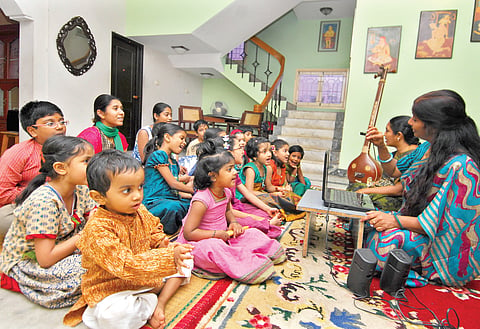

CHENNAI: Tucked away on a quiet lane in Raja Annamalaipuram, Brhaddhvani is not just a mere music training centre, but a research institute where people explore different forms of music. “Music is the first language any child is exposed to. Every mother sings to her child while it is still in the womb,” says veena exponent, musicologist-educationist-writer and founder of Brhaddhvani Karaikudi S Subramanian. “Music is all about sound. We connect art forms together, blending tradition and technology, at the centre,” adds the 70-year-old.
Besides music, the over two-decade-old centre offers training in sloka chanting, yoga and pranayama. It organises voice culture programmes, music appreciation courses, dance, theatre, folk art, drawing and sculpting.
“Every student is exposed to mediums of art like basic sketching so that he or she gets a chance to explore each realm. The minimum age at which children can join the centre is three. We focus on training students in carnatic music and help them understand our culture better. We have introduced Correlated Objective Music Education and Training (COMET). COMET helps one learn music independently. Once you get the methodology right, you can keep improvising, but classical music is the base. A keenly researched and scientifically proven method of music education helps immensely,” he says.
Subramanian, who holds a PhD in ethnomusicology from Wesleyan University in the US, says that music contributes significantly in the development of children and has a positive impact on their lives. “Music not only helps in the overall development of a student, but improves his or her performance in academics. It enhances the child’s memory power and creative ability. There’s a need to advocate a curriculum-based approach and the old guru-shishya parampara. We hope to combine the better of these two approaches to revolutionise music education,” he says. “Everyone deserves a chance to learn music. Music education isn’t for the elite. When you teach music to children, it should be fun, like throwing a ball,” he adds.
Brhaddhvani has been associated with legendary musicians including Tiruchy Sankaran, Pinakapani, Lalgudi G Jayaraman, Bombay Jayashri Ramnath, Sankari Krishnan, Dhananjayans and Pushpavanam Kuppusamy. The centre has more than 100 students at present, and permanent faculty including Kumudha, Sudha Harikrishnan and Sowmiya M,” says Subramanian.
“Professionals and students from foreign universities come here for research purposes,” he says. Brhaddhvani offers training for aspiring teachers. “We help teachers mould their training methodology and upgrading their teaching standards,” he says.
Subramanian says that the centre has tie ups with Art Links, which ensures seamless delivery of music curriculum at schools. “Music is made visual with colours and pictures. This is exclusively for the kindergarten. With fun activities and games that are guaranteed to make music interesting for children, the COMET methodology has had an overwhelming response from parents and a few like-minded school managements. For example, kids are made to count the windows of a colourful bus set up to learn the number of beats in aadi talam,” he says.
The centre has a well-equipped library, archives, recording studio and amphitheatre for students to perform and discuss. “These make one understand his or her voice better, place the pitch accordingly and proceed with confidence,” says Subramanian.
Brhaddhvani also trains differently-abled children. “We have had autistic and ambi-dexteritous kids learning with us. Music is used as a therapy here. We have a psychologist who gauges their IQ levels,” adds Subramanian.